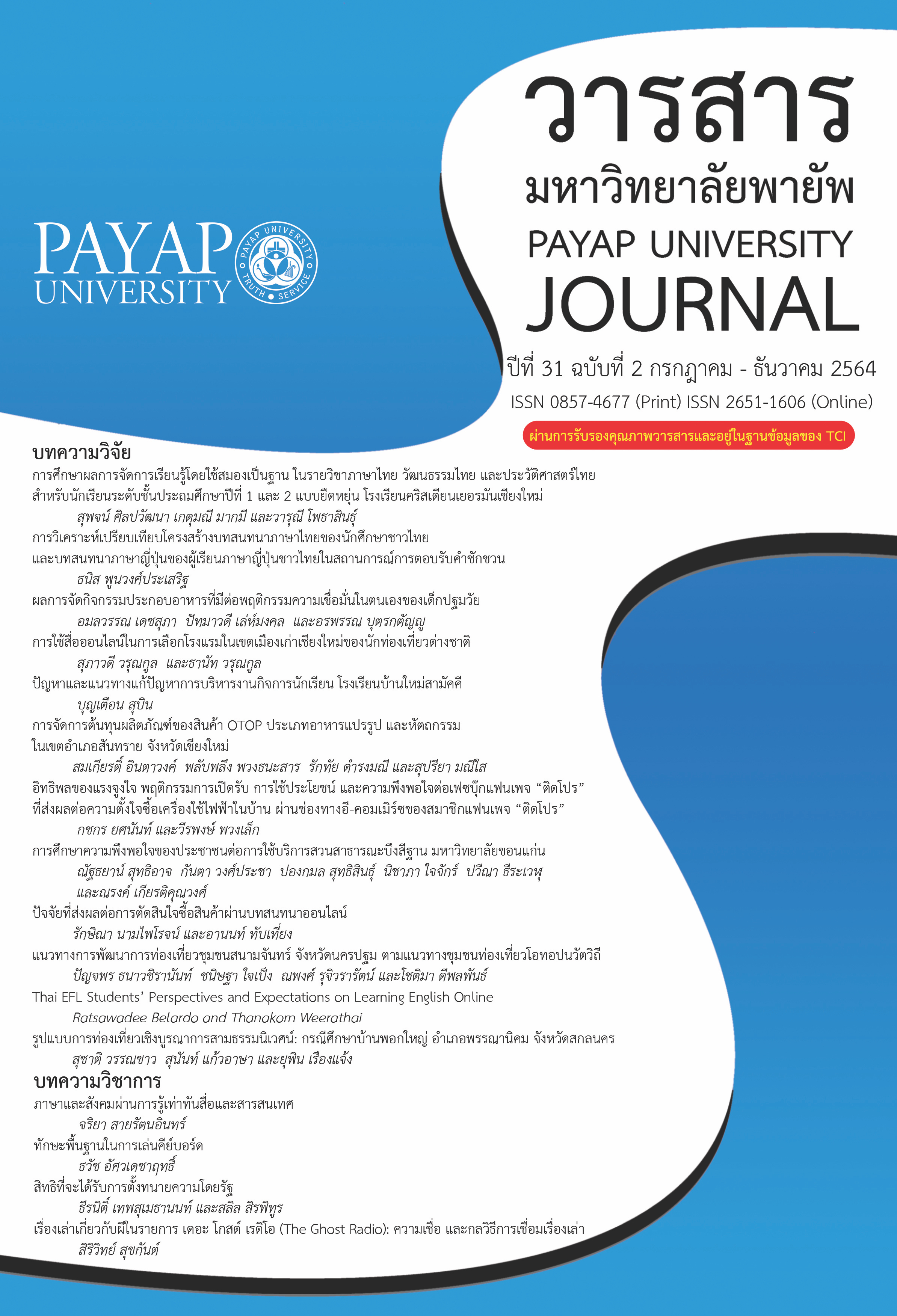Language and Society through Media and Information Literacy
Main Article Content
Abstract
This article aimed at presenting a possible way to use language analysis approach to investigate language in media by taking perspective of language and society. The article also included some examples of how to analyze persuasive strategies used in Twitter in order to strengthen "Media and Information Literacy". Information used was taken from Twitter presenting data relating to fake news situation in Thailand. The government Twitter accounts called Anti-FakeNews Center Thailand or @AFNCThailand was used. Rank’s model of persuasion was then utilized as a guideline to investigate persuasive language in social media. It was found that fake news used two major persuasive communication techniques including “intensification” to make the presented information important and “downplaying” was used to avoid mentioning about selected information. The analysis procedures might be useful as a guideline for training learners to filter content obtained from various media sources. Therefore, chances to be a victim of fake news can be minimized.
Article Details
References
กรรณิการ์ อัศวดรเดชา. (2550). การสื่อสารเพื่อการโน้มน้าวใจ. กรุงเทพฯ: ศูนย์หนังสือแห่งจุฬาลงกรณ์มหาวิทยาลัย.
ขนิษฐา ใจมโน. (2562). การสังเคราะห์และแนวโน้มการวิจัยด้านภาษาศาสตร์สังคม. วารสารมังรายสาร, 7(1), 67-86.
มหาวิทยาลัยราชภัฏบ้านสมเด็จเจ้าพระยา. สถาบันวิจัยและพัฒนา. (2563). คน กทม. คิดว่าข่าวปลอมจะทำให้เกิดความเข้าใจผิดและนำไปสู่ความขัดแย้ง, สืบค้นเมื่อวันที่ 22 เมษายน 2564. http://research.bsru.ac.th/%E0%B8%84%E0%B8%99-%E0%B8%81%E0%B8% 97%E0%B8%A1-%E0%B8%84%E0%B8%B4%E0%B8%94%E0%B8%A7%E0%B9% 88%E0%B8%B2%E0%B8%82%E0%B9%88%E0%B8%B2%E0%B8%A7%E0%B8%9B%E0%B8%A5%E0%B8%AD%E0%B8%A1%E0%B8%88%E0%B8%B0%E0%B8%97/
รัตนาภรณ์ จอมมูล. (2563). มาตรการทางกฎหมายในการกำกับควบคุมกำกับข่าวปลอมทางการเมืองบนโลกไซเบอร์. CMU Journal of Law and Social Sciences, 13(1), 1-23.
วีระพล วงษ์ประเสริฐ, ธัญวรัตม์ เจียรประดิษฐ์ และสุพัตรา โคบุตร. (2563). ทวิตเตอร์ (Twitter) กับ ทัศนคติทางการเมืองแบบประชาธิปไตยของเยาวชน ไทยที่สยามสแควร์. Rajapark Journal, 14(32), 141-154.
สุจิตรา แก้วสีนวล และอุดมลักขณ์ ธรรมปัญญา. (2563). ภูมิรู้ดิจิทัล: วิสัยทัศน์ของการเปลี่ยนแปลงนโยบายการศึกษาเพื่อยกระดับการรู้เท่าทันสื่อดิจิทัลของเด็กและเยาวชนไทย. วารสารการสื่อสารมวลชน, 8(1), 75-99.
สุธิดา พัฒนศรีวิเชียร. (2561). กลยุทธ์การใช้สื่อสังคม (social media) เพื่อรณรงค์ทางการเมืองในยุค สังคมเครือข่าย. Payap University Journal, 29(1), 27-41.
สุพัตรา หมอยาดี. (2563). การจัดการเรียนรู้เพื่อส่งเสริมความคิดสร้างสรรค์ ผ่านการบูรณาการใช้ทวิตเตอร์ สำหรับนักเรียนชั้นมัธยมศึกษา ปีที่ 3 โรงเรียนสงวนหญิง. Journal of Educational Technology and Communications Faculty of Education Mahasarakham University (JETC), 3(9), 128-139.
Beaulieu, S., Woll, N., French, L. M., and Duchemin, M. (2018). Language learners’ metasociolinguistic reflections: A window into developing sociolinguistic repertoires. System, 76, 210-218.
Han, S. (2019). Weathering the twitter storm. Information Technology and Libraries, 38(2), 37-48.
Hobbs, R., & Jensen, A. (2009). The past, present, and future of media literacy education. Journal of Media Literacy Education, 1(1), 1-11.
Labov, W. (1972). Sociolinguistic patterns. Philadelphia, PA: University of Pennsylvania Press.
Labov, W., Ash, S., Baranowski, M., Nagy, N., Ravindranath, M., and Weldon, T. (2006). Listeners' sensitivity to the frequency of sociolinguistic variables. University of Pennsylvania Working Papers in Linguistics, 12(2), 105-129.
Lazer, D. M. J., Buam, M. A., Benkler, Y., Berinsky, A. J., Greenhill, K. M., Menczer, F., … Zittrian, J. L. (2018). The science of fake news. Science Magazine, 359(6380), pp. 1094-1096.
Livingstone, S. (2019). Audiences in an age of datafication: Critical questions for media research. Television & New Media, 20(2), 170-183.
Potter, W. J. (2010). The state of media literacy. Journal of Broadcasting & Electronic Media, 54(4), 675-696.
Rank, H., (1976). Teaching about public persuasion. In D. Dietrich (ed.), Teaching about doublespeak (pp. 3-19). Urbana, IL: National Council of Teachers of English.
Wilkins, D. J., Livingstone, A. G., and Levine, M. (2019). Whose tweets?: The rhetorical functions of social media use in developing the Black Lives Matter movement. British Journal of Social Psychology, 58(4), 1-38.


